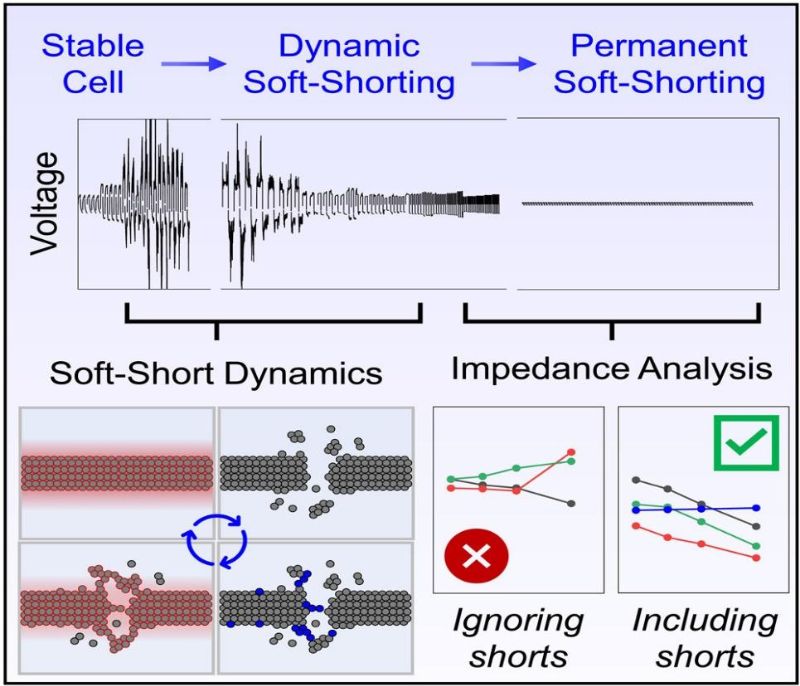‘Ghost’ Hunting: Researchers Detect Fault Hiding in Batteries
Argonne National Laboratory researchers have identified soft-shorts as an early precursor to permanent battery failure.
To cope with growing demands for electric vehicles (EVs), battery manufacturers are exploring avenues to augment power density, aiming to create batteries more compact yet capable of delivering greater power output. Nevertheless, every technology harbors inherent risks that demand careful consideration.
While working on all-solid batteries, Argonne National Laboratory (ANL) researchers have uncovered internal soft-shorts, a concealed phenomenon resulting in battery failure. What are these soft-shorts, and why are they called the “ghost” inside the battery?
Researchers discovered a “ghost” indicating battery failure. Image used courtesy of Adobe Stock
The “Holy Grail” of Battery Technologies
Research in batteries and electricity storage is currently a significant global focus, representing a major frontier for advancements in consumer technology.
In the context of EVs, solid-state batteries offer greater promise for superior energy density than a liquid electrolyte-based lithium-ion (Li-ion) battery. Additionally, solid-state batteries are considered safer since the solid electrolyte mitigates the risk of explosion or fire caused by the aqueous solution. The improved safety eliminates the need for safety components, which conserves additional space.
Anatomy of Li-ion and Li-ion solid-state batteries. Image used courtesy of FlashBattery
The battery electrodes are critical components significantly influencing power density. In particular, the choice of electrode materials affects the surface area available for electrochemical reactions and the kinetics of these reactions. Materials with high surface area and fast reaction kinetics can facilitate rapid charge and discharge processes, leading to higher power density. Additionally, the conductivity of the electrode materials influences the electron flow during charge and discharge, further influencing the battery's power performance.
Lithium-ion batteries, featuring lithium electrolytes, exhibit impressive power density, expanding the range of EVs. Further enhancing this density entails substituting graphite anodes with lithium metal anodes, creating lithium metal batteries many consider the “holy grail” in battery technology. Nevertheless, this technology presents inherent challenges, such as special failure modes, that must be solved before the batteries can reach mainstream adoption.
The Ghost Failure Mode in Solid-State Batteries
While developing new solid electrolytes for EV batteries, researchers at ANL came across an interesting phenomenon leading to battery failure. Specifically, their study shows that during battery testing in the lab, the batteries experienced intermittent voltage fluctuations attributed to soft-shorts or temporary short circuits.
Soft-shorts involve the growth of lithium filaments from the anode to the cathode (i.e., internal shorts) but less extensively than permanent short circuits. Soft-shorts exhibit dynamic or intermittent behavior, forming and dissolving rapidly due to factors like heat generation from electron flow and filament reactions with electrolytes. Although batteries with soft-shorts can function for hours or days, they ultimately lead to failure as filaments multiply over time.
Soft-shorting explained. Image used courtesy of Counihan et al.
One negative impact of soft-shorts is they diminish Columbic efficiency in solid-state batteries. Unfortunately, their elusive nature tends to evade detection through conventional voltage testing methods, earning them the title "ghosts." Precise characterization of temperature-dependent ionic and electronic circuit elements via impedance data is essential to discerning when a cell is afflicted with soft-shorting, wherein substantial amounts of both ionic and electronic currents flow through the cell concurrently.
Identifying soft-shorts in the initial stages offers insights into battery longevity and serves as a preemptive measure against potential failures. In their study, the research team employed nearly 20 novel techniques for detection and provided an analysis of each method’s pros and cons. For example, one technique tries to quantify the extent to which soft-shorts influence a battery's impedance to electrical current. Given that various battery components may influence this impedance, isolating the impact of soft-shorts will be necessary for researchers to more accurately evaluate battery health.
Better Understanding Batteries
The ANL research presents a critical advancement in understanding the failure mechanisms of solid-state batteries. With this newfound knowledge, the study offers insights vital for designing safer and more efficient battery systems for EVs and storage of renewable energy sources. Ultimately, unraveling the complexities of micro-level phenomena, the ANL researchers offer the industry a path toward safer and more efficient energy storage solutions.









